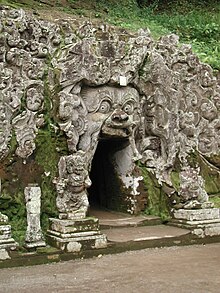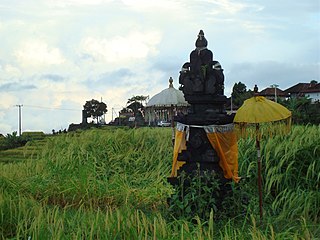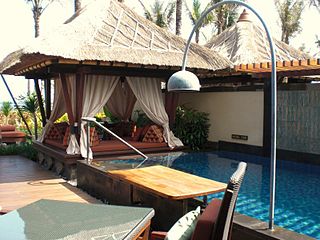



Goa Gajah, or Elephant Cave, is located on the island of Bali near Ubud, in Indonesia. Built-in the 9th century, it served as a sanctuary. [1]




Goa Gajah, or Elephant Cave, is located on the island of Bali near Ubud, in Indonesia. Built-in the 9th century, it served as a sanctuary. [1]
Although the exact origins of the cave are uncertain, it is believed to have been built as a place for spiritual meditation. [2] One folklore relates that it was created by the fingernail of the legendary giant Kebo Iwa. However, examining its style, the sanctuary was probably dated from the 11th century Bali Kingdom. The complex contains both Hindu and Buddhist imagery, as the cave contains lingam and yoni, symbols of Shiva, and the image of Ganesha, while by the river there are carved images of stupas and chattra, imagery of Buddhism.
The cave was rediscovered by Dutch archaeologists in 1923, but the fountains and bathing pool were not discovered until 1954. [3]
The temple is characterized by menacing faces that are carved into the stone – whose purpose is assumed to be the warding off of evil spirits. The primary figure was once thought to be an elephant, hence the nickname Elephant Cave. Other sources state that it is named after the stone statue of the Hindu God Ganesh (characterized by having the head of an elephant) located inside of the temple. [4] The site is mentioned in the Javanese poem Desawarnana written in 1365. An extensive bathing place on the site was not excavated until the 1950s. [5] The entrance of the cave is accessed only by walking down a long flight of stairs. [6] The inside of the temple is small and usually has trails of white smoke from the incense burning. [7] Visitors wearing shorts will be issued a sarong to tie around the waist before entering the courtyard. The complex also contains 7 statues of women (out of which 1 has been destroyed due to an earthquake) holding water pitchers that depict seven holy rivers of India: the Ganga River, Sarasvati River, Yamuna River, Godavari River, Sindhu River, Kaveri River, and Narmada River.
This site was added to the UNESCO World Heritage Tentative List on October 19, 1995, in the Cultural category, [8] but was pulled out along with 11 other sites on 2015.

The culture of Indonesia has been shaped by long interaction between original indigenous customs and multiple foreign influences. Indonesia is centrally-located along ancient trading routes between the Far East, South Asia and the Middle East, resulting in many cultural practices being strongly influenced by a multitude of religions, including Buddhism, Christianity, Confucianism, Hinduism, and Islam, all strong in the major trading cities. The result is a complex cultural mixture, often different from the original indigenous cultures.

Ubud is a town on the Indonesian island of Bali in Ubud District, located amongst rice paddies and steep ravines in the central foothills of the Gianyar regency. Promoted as an arts and culture centre, it has developed a large tourism industry. It forms a northern part of the Greater Denpasar metropolitan area.

Besakih Temple is a pura complex in the village of Besakih on the slopes of Mount Agung in eastern Bali, Indonesia. It is the most important, largest, and holiest temple of Balinese Hinduism, and one of a series of Balinese temples. Perched nearly 1000 meters up the side of Gunung Agung, it is an extensive complex of 23 separate but related temples with the largest and most important being Pura Penataran Agung. The temple is built on six levels, terraced up the slope. The entrance is marked by a candi bentar, and beyond it, the Kori Agung is the gateway to the second courtyard.

Tanah Lot is a rock formation off the Indonesian island of Bali. It is home to the ancient Hindu pilgrimage temple Pura Tanah Lot, a popular tourist and cultural icon for photography.

Subak is the water management (irrigation) system for the paddy fields on Bali island, Indonesia. It was developed in the 9th century. For the Balinese, irrigation is not simply providing water for the plant's roots, but water is used to construct a complex, pulsed artificial ecosystem. The system consists of five terraced rice fields and water temples covering nearly 20,000 hectares. The temples are the main focus of this cooperative water management, known as subak.

A candi is a Hindu or Buddhist temple in Indonesia, mostly built during the Zaman Hindu-Buddha or "Hindu-Buddhist period" between circa the 4th and 15th centuries.

The National Museum of Indonesia is an archeological, historical, ethnological, and geographical museum located in Jalan Medan Merdeka Barat, Central Jakarta, right on the west side of Merdeka Square. Popularly known as the Elephant Museum after the elephant statue in its forecourt, its broad collections cover all of Indonesia's territory and almost all of its history. The museum has endeavoured to preserve Indonesia's heritage for two centuries.

Mahadeva Temple, Tambdi Surla is a 13th-century Shaivite temple in the Kadamba style dedicated to Lord Shiva, one of the main deities in Hinduism, and is an active place of Hindu worship. It is an ASI protected Monument of National Importance in Goa.

The Moon of Pejeng, also known as the Pejeng Moon, in Bali is the largest single-cast bronze kettle drum in the world. and "the largest known relic from Southeast Asia's Bronze Age period." It is "considered highly sacred by local people." It is thought to be a relic of early rice cultivation rituals.

Pura Ulun Danu Beratan, or Pura Bratan, is a major Hindu Shaivite temple in Bali, Indonesia. The temple complex is on the shores of Lake Beratan in the mountains near Bedugul. The water from the lake serves the entire region in the outflow area; downstream there are many smaller water temples that are specific to each irrigation association (subak).

Rajasthan is one of the most popular tourist destinations in India, for both domestic and international tourists. Rajasthan attracts tourists for its historical forts, palaces, art and culture with its slogan "Padharo Mhare Desh " The capital city, Jaipur, also known as Pink City, is a very popular tourist destination and is a part of the Golden Triangle. The Walled City of Jaipur is only the second Indian city to be recognized as a UNESCO World Heritage Site, after Ahmedabad.

Tirta Empul temple is a Hindu Balinese water temple located near the town of Tampaksiring, Bali, Indonesia. The temple compound consists of a petirtaan or bathing structure, famous for its holy spring water, where Balinese Hindus go to for a ritual purification called Melukat. The temple pond has a spring which gives out fresh water regularly, which Balinese Hindus consider to be holy or amritha. Tirta Empul means Holy Spring in Balinese.

Balinese architecture is a vernacular architecture tradition of Balinese people that inhabits the volcanic island of Bali, Indonesia. Balinese architecture is a centuries-old architectural tradition influenced by Balinese culture developed from Hindu influences through ancient Javanese intermediary, as well as pre-Hindu elements of native Balinese architecture.
Bedulu, also spelt Bedahulu or Bedaulu, is a historical site in Bali, Indonesia. It is situated about two kilometer to the west of today Gianyar town.

It is quite difficult to define Indonesian art, since the country is immensely diverse. The sprawling archipelago nation consists of 17.000 islands. Around 922 of those permanently inhabited, by over 1,300 ethnic groups, which speak more than 700 living languages.

Tourism in India is economically important and ever-growing. The World Travel & Tourism Council calculated that tourism generated ₹14.02 lakh crore (US$180 billion) or 9.6% of the nation's GDP in 2016 and supported 40.343 million jobs, 9.3% of its total employment. The sector is predicted to grow at an annual rate of 6.8% to ₹28.49 lakh crore (US$360 billion) by 2027.

The archaeology of Indonesia is the study of the archaeology of the archipelagic realm that today forms the nation of Indonesia, stretching from prehistory through almost two millennia of documented history. The ancient Indonesian archipelago was a geographical maritime bridge between the political and cultural centers of Ancient India and Imperial China, and is notable as a part of ancient Maritime Silk Road.

Pura Goa Lawah is a Balinese Hindu temple or a pura located in Klungkung, Bali, Indonesia. Pura Goa Lawah is often included among the Sad Kahyangan Jagad, or the "six sanctuaries of the world", the six holiest places of worship on Bali. Pura Goa Lawah is noted for built around a cave opening which is inhabited by bats, hence its name, the Goa Lawah or "bat cave".

Cave temples are subterranean sacred buildings carved into the rock or created in a natural cave. Cave temples and monolithic rock temples carved out of the stone are a form of early natural architecture and rock construction, a building technique in solid rock closely related to sculpture. The most extensive artificially created cave temple complexes (subterranea) originated in India, where about 1200 complexes are documented, and in the neighboring regions of Asia.